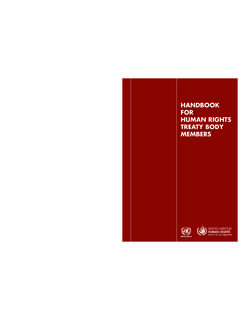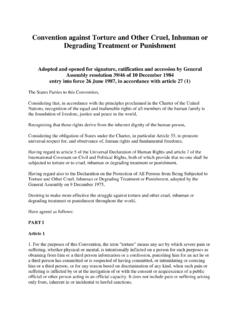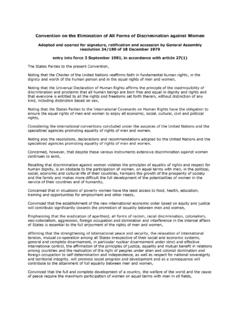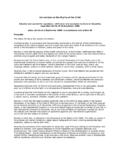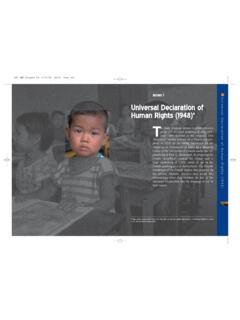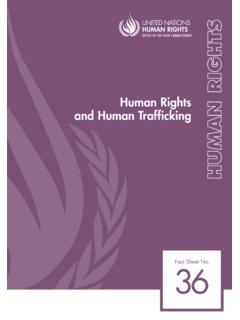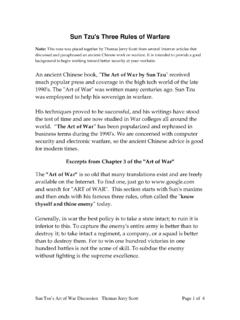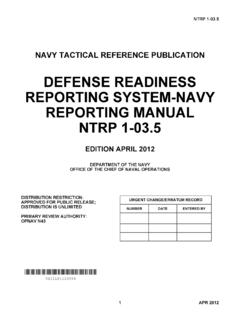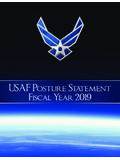Transcription of Fact Sheet No.13, International Humanitarian Law …
1 Fact Sheet , International Humanitarian Law and human RightsIntroductionInternational Humanitarian law has a brief but eventful history. It was not until the second half ofthe nineteenth century that nations agreed on International rules to avoid needless suffering inwars-rules they bound themselves to observe in a then, the changing character of armed conflict and the destructive potential of modernweapons have made necessary many revisions and extensions of Humanitarian law in long andpatient Fact Sheet traces the evolution of International Humanitarian law and outlines its present- dayscope and meaning both for combatants and for civilians caught up in armed of all, a definition is needed. What is International Humanitarian law? This body of law can bedefined as the principles and rules which limit the use of violence in times of armed conflict.
2 Theaims are:To protect persons who are not, or are no longer, directly engaged in hostilities-the wounded,shipwrecked, prisoners of war and civilians;To limit the effects of violence in fighting to the attainment of the objectives of the evolution of International law related to the protection of war-victims and to the conduct of warhas been strongly affected by the development of human rights legal protection after the SecondWorld War. The adoption of important International instruments in the field of human rights-such asthe Universal Declaration of human Rights (1948), the European Convention on human Rights(1950) and the International Covenant on Civil and Political Rights (1966)-contributed to affirm theidea that everyone is entitled to the enjoyment of human rights, whether in time of peace or wartime or public emergency, however, the enjoyment of certain human rights may berestricted under certain circumstances.
3 Article 4 of the International Covenant on Civil and PoliticalRights allows States to take measures temporarily derogating from some of their obligations underthe Covenant "in time of public emergency which threatens the life of the nation", but only "to theextent strictly required by the exigencies of the situation". Article 15 of the European Convention onhuman rights contains a similar rule. Annually the Sub- Commission on Prevention of Discriminationand Protection of Minorities carries out a review of states of emergency and respect for humanrights during such , the need of safeguarding human rights even during wartime has been fully recognized;article 3 of the four Geneva Conventions on Humanitarian law of 1949 provides that in times ofarmed conflict persons protected by the conventions should "in all circumstances be treatedhumanely, without any adverse distinction founded on race, colour, religion or faith, sex, birth orwealth, or any other similar criteria".
4 At the forthcoming 43rd session of the Sub-Commission on Prevention of Discrimination andProtection of Minorities (5-30 August 1991) a report of the Secretary-General on educationregarding respect for human rights in armed conflicts will be presented under item 4 of theprovisional agenda ( ). Two years ago the Sub-Commission adopted resolution1989/24 on " human rights in times of armed conflict", deploring the frequent lack of respect duringsuch conflicts of relevant provisions in International Humanitarian law and the law of human its forty-sixth session the Commission on human Rights adopted resolution No. 1990/60recognizing the vital role of the International Committee of the Red Cross in the dissemination ofinternational Humanitarian law and calling upon States "to give particular attention to the educationof all members of security and other armed forces, and of all law enforcement agencies, in theinternational law of human rights and International Humanitarian law applicable in armed conflicts".
5 Three main currents have contributed to the making of International Humanitarian law. They are the"law of Geneva", represented by the International Conventions and Protocols established under theaegis of the International Committee of the Red Cross (ICRC) with the protection of the victims ofconflict as their central concern; the "law of The Hague", based on the results of the PeaceConferences in the capital of the Netherlands in 1899 and 1907, which dealt principally with thepermissible means and methods of war; and the efforts of the United Nations to ensure that humanrights are respected in armed conflicts and to limit the use of certain , these three currents have merged to form one stream of the beginning ..As French and Austrian armies fought the battle of Solferino in northern Italy in June, 1859, theidea of International action to limit the suffering of the sick and wounded in wars was born in themind of Henri Dunant, a young Swiss found himself, more or less by accident, among thousands of French and Austrian woundedafter the battle, and with a few other volunteers did what he could to ease their suffering.
6 Appalledby what he had seen, he then wrote a book Un souvenir de Solferino, published in 1862, in which hesuggested that national societies should be created to care for the sick and wounded irrespective oftheir race, nationality or religion. He also proposed that States should make a treaty recognizing thework of these organizations and guaranteeing better treatment for the four friends, Henri Dunant then set up the International Committee for Aid to the Wounded(soon to be renamed the International Committee of the Red Cross). Dunant's ideas met a wideresponse. In several countries national societies were founded and at a diplomatic conference inGeneva in 1864 the delegates of 16 European nations adopted the Convention for the Ameliorationof the Condition of the Wounded in Armies in the document, the First Geneva Convention, enshrined the principles of universality and tolerancein matters of race, nationality and religion.
7 The emblem, a red cross on a white field, was adoptedas the distinguishing mark of military medical personnel. In Islamic countries, the emblem is a redcrescent on a white field. Medical staff and installations were from this time on to be considered Convention formally laid the foundations of International Humanitarian agreements broadenedThe need to give broader scope to the Geneva Convention was soon evident. In 1868, a new draftconvention was drawn up with the idea of extending the principles adopted four years earlier tomaritime conflicts. In another move, the St. Petersburg Declaration of 1868 called on States not touse arms which cause unnecessary suffering. The Declaration prohibited the use of Peace Conferences at The Hague in 1899 and 1907 adopted conventions defining the laws andcustoms of warfare and declarations forbidding certain practices, including the bombardment ofundefended towns, the use of poisonous gases and soft-nosed bullets.
8 The conferences failed toagree on a system of compulsory arbitration as a means of settling disputes which threaten 1906, the First Geneva Convention was revised to give greater protection to victims of war onland, and in the following year all its provisions were formally extended to situations of war at for the Geneva Convention and operations led by the ICRC played a vital role in saving livesand preventing needless suffering in the First World War (1914-1918). However, the disas troushuman toll of the conflict convinced the International community that the Convention must this spirit, a conference in Geneva in 1929 adopted a Convention with better provisions for thetreatment of the sick and wounded, and a second Convention on the treatment of prisoners of years earlier, a Protocol had been adopted at a League of Nations conference to prohibit theuse of asphyxiating and poisonous Spanish Civil War (1936-1939) and the Second World War (1939-1945) provided compellingevidence of the need to bring International Humanitarian law once again into line with the changingcharacter of decision was taken to make a fresh start and new Geneva Conventions were drawn up covering,respectively, the sick and wounded on land (First Convention)
9 , wounded, sick and shipwreckedmembers of the armed forces at sea (Second Convention), prisoners of war (Third Convention), andcivilian victims (Fourth Convention). These Conventions were adopted at an International diplomaticconference held in Geneva from April to August, important innovation-common to all the Contentions- is that they establish minimum rules to beobserved in internal armed four Geneva Conventions remain in force today. However, over the past four decades, newforms of armed conflict, often sharp and violent but localized and involving limited numbers oftroops and other combatants, have arisen. The changing nature of armed struggle called for , the Diplomatic Conference on the Reaffirmation and Development of InternationalHumanitarian Law, which met in Geneva from 1974 to 1977, adopted two Additional Protocols to the1949 I deals with the protection of victims of International conflicts.
10 Protocol II concerns thevictims of internal armed conflicts, including those between the armed forces of a government anddissidents or other organized groups which control part of its territory, but does not deal withinternal disturbances and tensions in the form of riots, or other isolated and sporadic acts Diplomatic Conference also recommended that a special conference be called on the question ofprohibiting on Humanitarian grounds the use of specific conventional 31 December 1990, 164 States were parties to the Geneva Conventions, while 99 States hadratified or acceded to Protocol I and 89 States had ratified or acceded to Protocol II. At the UnitedNations General Assembly's request, the Secretary-General of the United Nations reportsperiodically on the state of acceptance of the from the ProtocolsCertain aspects of the Protocols, as the most recent development in the "law of Geneva", merit awider description.
